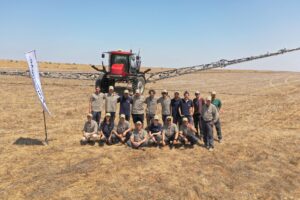Many agritech startups aim to help farmers manage and protect their crops from invasive weeds and pests. They include new chemical and biological pesticides and herbicides, and new gadgets and platforms for precision spraying and field treatments. But individually, in weed science especially, those technologies won’t move the needle because the underlying science hasn’t changed in decades, argues Hadyn Parry, chairman of MoA Technology.
“No herbicides have been developed with a new mode of action for about 30 years. All the big companies have done is introduce new versions of the same things,” he told AFN.
This, in turn, has led to an “herbicide resistance crisis” in agriculture that Parry compares to the antibiotic resistance crisis in humans. Weeds, exposed to the same small number of chemical products over decades, are becoming increasingly resistant. Tightening regulation, meanwhile, limits the number of products available for use, which only accelerates the problem.
It’s a problem that puts global food security at risk. In one study, the Weed Science Society of America found that as much as 50% of soy and corn production in the US and Canada would be under threat if weeds cannot be controlled.
Research suggests that weed resistance to herbicides can be slowed or mitigated with integrated weed management practices that include tilling or crop rotation in addition to herbicide use. But these practices are labor-intensive, so many farmers rely solely on chemical treatments, Parry explains.
What is needed, argues Parry, is the discovery of new “modes of action”—the manner in which chemical and biological herbicides attack the plant—around which new herbicide products can be developed. That, of course, is precisely what his startup, MoA, is trying to accomplish. To support that effort, it has just raised a £6.3 million ($7.7 million) Series A funding round co-led by Oxford Sciences Innovation and Parkwalk Advisors, an investment fund focused on university spinouts.
Discovery first, chemistry next
MoA is a spin-out from Oxford University’s Plant Sciences Department. The company is building a discovery process for identifying new ways to attack and kill weeds, opening up opportunities to develop new and sustainable herbicides.
“If you look at the current chemicals in the market, there are only about 20 ways to kill weeds,” Parry explains. These include mimicking plant hormones, disrupting the photosynthesis process, or interfering with the lipids that form plants’ cell walls.
It sounds gruesome, but MoA is hunting for new ways to kill a plant. Its platform compiles libraries of natural and synthetic compounds, then combines imaging technology and artificial intelligence to screen the compounds and “cluster” them based on how they interact with plant biology. It employs a “unique combination of genetics, trait analysis, and data analytics,” the company said in a statement.
“We call this system Galaxy; it’s like a visual map. Much the same way stars cluster in a galaxy, we see clusters of compounds. And what we’re looking for are the ones that stand completely on their own,” Parry says.
“The trick here is to focus on the lock, not the key,” he continues. “If we find something that even weakly affects [a plant], we can work backwards on the chemistry. It’s completely different from how the industry currently works.”
The technology was developed by Oxford’s Liam Dolan and Clement Champion. But to succeed, the startup must have access to a diverse chemistry library. Parry believes this is easier for MoA than other industry players because its platform is able to work with very small chemical quantities.
MoA’s Series A round will allow the company to continue with its aggressive compound screening schedule and advance promising leads into glasshouse testing against various weeds and crops. “At that point, we can go into the field for the first time,” Parry notes.
To reach that point, the company has two other platforms that come into play once Galaxy identifies new potential modes of action. The Target platform hones in on specific proteins associated with modes of action. “The information from MoA Target guides researchers to novel, safer, more sustainable and effective herbicide active ingredients,” the company’s website states.
Then the MoA Select can validate a mode of action and identify and test new chemistries. “At this stage, promising leads can be progressed for glasshouse and field testing,” according to MoA’s website.
Actually, just discovery
MoA’s focus is on mode-of-action discovery, rather than developing new herbicides as an end goal. “I doubt we’d go to market ourselves. Once you go into the field, your costs spiral,” Parry says, noting that with field testing and regulatory compliance, it can cost $200 million to get a new product to market. “We aren’t set up for that and don’t have the funding for it.”
Instead, MoA would look to partner with major agriculture chemical companies or some of the up-and-coming players.
He stresses that getting to that point is a matter of urgency. “I was talking to a wheat farmer in the UK, and he said he has only one product for controlling blackgrass [a weed]. That product is under [regulatory] threat,” he says, which means wheat farmers would have to rely entirely on other, more energy-intensive weed management solutions or change crops entirely. “It’s a thin line between where we are now and the tipping point.”

















Sponsored
International Fresh Produce Association launches year 3 of its produce accelerator